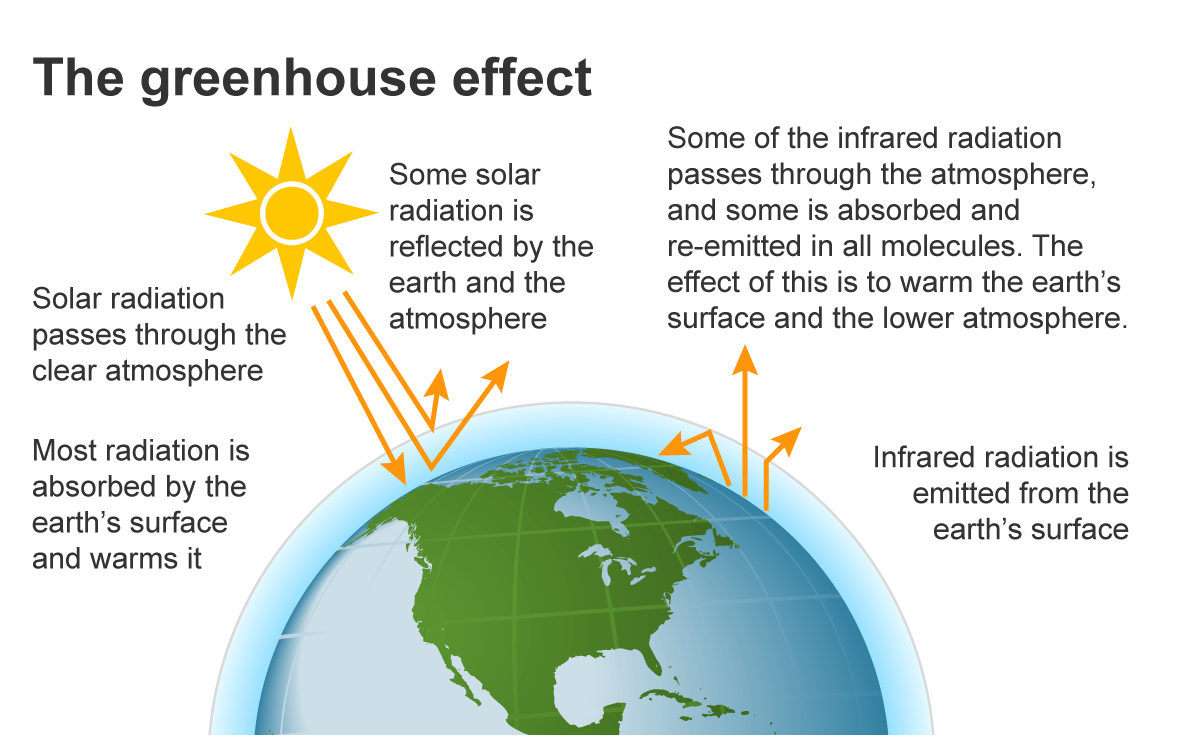Greenhouse gases include carbon dioxide, methane, nitrous oxides, and water vapor. (Water vapor, which responds physically or chemically to changes in temperature, is called “feedback.”) Scientists have determined that carbon dioxide’s warming effect helps stabilize Earth’s atmosphere.
Green House Gases
Greenhouse gases are those gases, which have the property of absorbing and re-emitting infrared radiation back to the earth’s surface thus contributing to the greenhouse effect. China is the top GHG emitter followed by the US and India.

Major Green House Gases
Water Vapour
It is one of the major important greenhouse gas. As a greenhouse gas, the higher concentration of water vapor can absorb more thermal Infrared energy radiated from the Earth, thereby further warming the atmosphere. And the warmer atmosphere can hold more water vapor and thus contribute to the warming of the earth.
Carbon dioxide (CO2):
CO2 is the biggest contributor to GHG emissions.
Natural Source: CO2 is naturally formed in the atmosphere with the carbon cycle. However, human activities are the major cause of the increase in carbon dioxide in the atmosphere.
Anthropogenic Source:
1. Burning of fossil fuel is the primary source of CO2.
2. Fossil fuel used for gasoline and diesel used for transportation and electricity
3. Land use, such as through deforestation, land clearing for agriculture, and degradation of soils.
Removal: Through reforestation, adoption of clean technologies, non-usage of fossil fuels, sustainable production and consumption measures, and improvement of soils we can build back normalcy.
Methane (CH4)
The sources of Methane include both natural and man-made.
Natural Sources: It is released from the decomposition of organic matter from wetlands and animal wastes. And several minor sources include termites, oceans, sediments, volcanoes, and wildfires, etc.
Human-Induced activities: Human activities like:
- Agriculture (paddy cultivation),
- livestock rearing (excreta of cattle and other livestock),
- Crude oil & natural gas production and refining
- burning of fossil fuel and, wood,
- landfills- As waste decomposes, methane is emitted from landfills.
- wetlands,
- fertilizer factories etc.
Lesser Green House Gases
Surface ozone
ozone Surface level is emitted due to air pollution. Surface-level ozone is dangerous to the environment and human health whereas stratospheric ozone keeps the earth’s radiation in balance.
Sources:
Natural source: the natural source of surface ozone is the subsidence of stratospheric ozone from the upper atmosphere.
Anthropogenic sources: The surface ozone is formed when it reacts with nitrogen oxides (from vehicles) and volatile organic compounds (from paints, solvents, printing inks, petroleum products, vehicles, etc.) in the presence of sunlight.
Nitrogen Oxide
Nitrous oxide (N2 O) is formed naturally in the atmosphere in the process of Earth’s nitrogen cycle from various sources.
Natural sources: emissions of Nitrogen Oxide are mainly from bacteria breaking down nitrogen in soils and the oceans.
Anthropogenic sources:
1. Transport: Nitrogen dioxide is released from fossil fuel combustions in vehicles
2. Agriculture: Application of fertilizers like Urea (nitrogen) in farming
3. Livestock: It is released into the atmosphere during bacterial down of livestock manure and urine.
4. Industries: Fertilizer manufacturing industries and wastewater treatment.
Removal: Nitrous oxide can be removed from the atmosphere when it is absorbed by certain types of bacteria or destroyed by ultraviolet radiation or chemical reactions.
Fluorinated Gas
There are four main categories of fluorinated gases—
1. Hydrofluorocarbons (HFCs),
2. Perfluorocarbons (PFCs), and
3. Sulfur hexafluoride (SF6)
4. Nitrogen trifluoride
Sources: These fluorinated gases are emitted from Industries like semiconductor manufacturing, aluminium and the use of refrigerants, aerosol propellants, solvents, and fire retardants etc.
Fluorinated gases are sometimes used as substitutes for stratospheric ozone-depleting substances(e.g., chlorofluorocarbons (CFCs), hydrochlorofluorocarbons (HCFCs), and halons).
However, fluorinated gases are proved to have very high global warming potential and last long in the atmosphere. When these gases are emitted, they mix well with the gases present in the atmosphere, spread around the world.
Removal: Adopting sustainable production processes and HFCs, Kigali amendment to Montreal protocol mandates phasing out of HFCs and CFCs.

.
Read More Articles on Geography
You Can Follow on Youtube – Score Better
Join Us on Telegram For More Update
.
